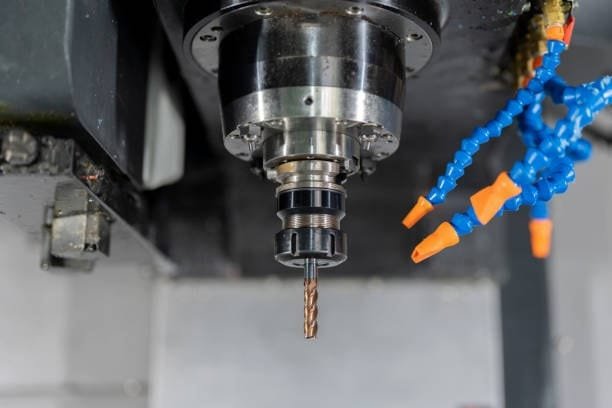From aerospace and automotive to medical and consumer electronics, CNC (Computer Numerical Control) machining is among the most flexible and exact manufacturing techniques applied in many different sectors. Since different materials have distinct properties that affect machinability, surface polish, and functional attributes, the final product’s strength, durability, performance, and cost-effectiveness depend much on the material chosen in CNC machining. Knowing the several kinds of materials that are accessible for CNC machining, their unique qualities, benefits and drawbacks, as well as their particular uses, can help one choose the appropriate one for their project.
Understanding CNC Machining Materials

Using cutting, milling, drilling, or turning operations to produce a precise final product with tight tolerances and complex geometries, CNC machining is a subtractive manufacturing process or technique whereby material is removed from a solid object. Not only does the efficiency of the machining process but also the lifetime, mechanical qualities, and general quality of the final product depend much on the materials used in CNC machining. Three main categories can be used to generally classify CNC machining materials: metals, plastics, and composites; each has special advantages and drawbacks depending on the particular needs of the end application cnc materials.
1. Metals in CNC Machining

Because of their great mechanical qualities, strength, durability, and resistance to hostile surroundings, metals are among the most often used materials in CNC machining medium carbon steel. These materials are perfect for components used in aerospace, automotive, medical, and industrial uses since they are extensively used in sectors where high performance, dependability, and precision are needed.

Aluminum
Because it provides a mix of lightweight qualities, great corrosion resistance, outstanding thermal and electrical conductivity, and excellent machinability, aluminum is among the most often used materials in CNC machining. Among the commonly used aluminum grades are 6061, which is well known for its balanced strength and corrosion resistance; 7075, a high-strength aluminum alloy used extensively in aerospace applications; and 2024, which offers great fatigue resistance. Aluminum is frequently chosen for manufacturing prototypes, automobile parts, electronic enclosures, airplane components, and lightweight industry parts because of its simplicity of machining. Although aluminum is reasonably priced and has a great strength-to-ratio, it is not as strong as some other metals like steel and is more likely to surface scratch.
Steel
Perfect for structural and load-bearing uses, steel is another often utilized CNC machining material with extraordinary strength, toughness, and durability. While its density makes steel heavier than aluminum and its machining complexity compared to softer metals are its main drawbacks, its great mechanical strength, adaptability, and wear resistance define its main advantages titanium alloys.
Titanium
Because of its remarkable strength-to—-weight ratio, great corrosion resistance, and biocompatibility—which fit for high-performance uses in aerospace, medical implants, and automotive industries— titanium is a premium material utilized in CNC machining. Common titanium grades are Grade 2, commercially pure and with strong corrosion resistance; Grade 5 (Ti-6Al-4V), an alloyed version with great strength and hardness. Although titanium is far more expensive than other metals and is difficult to process because of its tendency to create heat and wear out cutting equipment rapidly, it is extremely desirable for applications needing extraordinary toughness and lightweight qualities.
Brass and Copper
Because of their great electrical and thermal conductivity, corrosion resistance, and visual appeal—which fit applications in electrical components, decorative hardware, plumbing fittings, and musical instruments—brass and copper are extensively utilized in CNC machining right cnc machining materials. While copper, such C110, is extremely conductive and often utilized in electrical applications, brass—especially the C360 grade—is noted for its simplicity of machining and clean finish. Although these materials are easy to work with, copper is somewhat soft and prone to deformation; brass is sturdy but more costly than the alloy steel and some other often machined metals.

2. Plastics in CNC Machining
In CNC machining when lightweight, corrosion resistance, electrical insulation, or cost-effectiveness are needed, plastics are a common substitute for metals. Medical equipment, automobile components, consumer electronics, and other industrial applications and uses requiring non-metallic parts all make frequent use of these materials.
ABS (Acrylonitrile Butadiene Styrene)
Because of its great impact resistance, lightweight qualities, and heat resistance—which make ABS fit for uses including automobile components, consumer electronics, and industrial housings—this plastic is among the most often used ones in CNC machining. Though ABS is less strong than metals and less highly resistant to UV exposure, it is cheap and quick to make.

Acrylic (PMMA)
Perfect for uses like display cases, lenses, and light covers, acrylic, sometimes known as PMMA, is a clear plastic material with outstanding optical clarity, shatter resistance, and lightweight qualities. Although acrylic is easy to produce and offers outstanding optical qualities, it is more fragile than other polymers and may scratch readily.
Nylon
Strong, impact-resistant plastic with low friction and self-lubricating qualities, nylon is perfect for bearings, gears, bushings, and automotive components. Although nylon is lightweight and shows great wear resistance, it absorbs moisture, which over time can compromise its mechanical qualities and dimensional stability.
POM (Delrin)
Commonly known as Delrin, polyoxymethylene (POM) is a hard, low-friction plastic with strong chemical resistance that is appropriate for precision mechanical components including bearings, gears, and medical tools. Delrin has limited heat resistance relative to metals, and carbon steel, but it provides outstanding dimensional stability and wear resistance.
PTFE (Teflon)
Applied in seals, gaskets, and non-stick coatings, PTFE, sometimes known as Teflon, is a highly chemical-resistant, heat-resistant, low-friction polymeric substance. Although PTFE has exceptional chemical and heat resistance, its softness and propensity to deform readily make machining challenging.
3. Composites in CNC Machining

Composites are designed materials composed of two or more separate components that offer improved mechanical qualities, hence fit for high-performance uses where lightweight and strength are paramount.
Carbon Fiber Reinforced Polymer (CFRP)
Extremely light-weight, high-strength material utilized extensively in aerospace, sports, and automotive applications is carbon fiber reinforced polymer (CFRP). Although CFRP is costly, complex to machine, and prone to brittleness at the margins, it offers extraordinary stiffness and strength.
Fiberglass
Commonly found in boats, car panels, and other industrial and construction applications and components, fiberglass is a strong, lightweight, corrosion-resistant composite material. Although fiberglass is less expensive than carbon fiber, it can be abrasive to cutting tools and calls for specific machining methods.
The Impact of High Temperatures on CNC Machining Materials

Extreme heat can cause some materials to degrade, weaken, or lose their structural integrity, hence it is imperative to take high temperature response of the selected materials for CNC machining under consideration. Some plastics and metals are unsuitable for uses where thermal stability is needed since they start to distort, melt, or chemically break down with heat above their threshold.
One often used plastic that suffers especially from high temperatures is polyvinyl chloride (PVC). Although PVC is known for its great fire resistance, its working temperature range is somewhat limited—about 176°F. PVC starts to lose its stability as temperatures climb over this level and approach 280°F, so it is not fit for uses calling for continuous heat. Certain materials, on the other hand, are made especially to resist high temperatures while nevertheless preserving structural integrity.
One such substance quite resistant to high temperatures is polyisocyanurate. By use of a chemical curing process, this thermoset plastic retains its stiff and stable form even in very high heat settings. Polyisocyanues stays the same unlike thermoplastics, which can soften and melt under heat; this makes it the perfect material for CNC machining projects needing great thermal resistance.
Particularly if the final product will be utilized in surroundings where heat exposure is a consideration, it is imperative to assess how well a material will tolerate high temperatures before selecting one for CNC machining. Knowing the thermal stability of the component will help to guarantee that it functions as expected without sacrificing durability or safety.
Evaluating the Weight and Stress Capacities of CNC Machining Materials

The weight and stress capability of the CNC machining material also play significant roles in choice. The performance, durability, and cost of a machined component can all be much affected by the weight of a material. While some uses call for lightweight materials that increase mobility and efficiency, others call for hefty, load-bearing materials with great strength.
Heavyweight Materials and Their Strengths
When great stress resistance and durability are needed in CNC machining, heavy materials such metals and dense composites are often used. Applications like industrial machinery, building components, and automotive parts that call for the ability to resist significant mechanical stresses will find these materials perfect. Strong materials efficiently absorb tension, therefore preventing wear and tear even under very demanding circumstances extreme temperatures. They might, however, also be expensive to manufacture and move and might call for extra structural support.
Lightweight Materials and Their Applications
Lightweight materials include aluminum, steel alloys, polymers, and carbon fiber composites provide a great substitute for situations when lowering weight is a top concern. Aerospace, consumer electronics, and automotive sectors—where efficiency, fuel economy, and portability depend on weight reduction—regular use of these materials is evident. Many of these lightweight materials have great stress absorption and durability, which qualifies them for different uses even if they are not heavy.

Though their cost can occasionally be more, especially in relation to sophisticated materials like carbon fiber composites, lightweight materials may not necessarily offer the same load-bearing capacity as heavier materials. When choosing materials for CNC machining, manufacturers have to give much thought to the mix between weight, strength, and cost.
Making the Right Choice for Your CNC Machining Project
Choosing the correct material for CNC machining depends on evaluating the particular requirements of the project and deciding which material features are absolutely necessary for best performance. While certain uses give stress absorption, durability, or lightweight qualities top priority, others call for heat resistance.
Through rigorous evaluation of every material’s properties—such as thermal stability, weight capacity, and general strength—manufacturers may make selections right materials that guarantee the machined final product satisfies the necessary criteria for functioning and lifetime.

Additional Durability Factors to Consider in CNC Machining Materials
Choosing materials for CNC machining requires one to realize that strength is not just defined by the capacity of an object to bear weight. Many other elements of durability help a material to perform generally and last in different uses. Tensile strength, endurance strength, wear resistance, and hardness—all of which define a material’s performance under various conditions—also influence each other.
Tensile Strength: Resistance to Breaking Under Tension
Tensile strength in materials is their capacity to resist pressures of pulling or stretching without breaking. For uses like structural components, cables, and fasteners where the material will be under tension, this is absolutely vital. For these uses, high tensile strength materials—like steel and carbon fiber—are perfect as they can withstand significant stress without breaking.
Endurance Strength: Stress Absorption Over Time
Measures of endurance strength evaluate a material’s ability to endure continuous or repetitive stress without breaking or degrading. Some materials may look sturdy at first but, with cyclic load or fatigue stress, they gradually weaken. Excellent endurance strength of materials like titanium and hardened stainless steel often makes them perfect for uses needing long-term durability and mechanical fatigue resistance.
Wear Resistance: Friction and Self-Lubrication Properties
Another important consideration is wear resistance, particularly for moving parts that come into continual friction. Resistance to wear and abrasion of a material guarantees a longer lifetime and lowers maintenance needs. One very good example of a material with outstanding wear resistance is ultra-high molecular weight polyethylene. Like Teflon® UHMW polyethylene has great self-lubricating qualities but improved abrasion resistance, which makes it perfect for mechanical bearings, sliding components, and conveyor belts.
Hardness: Resistance to Surface Deformation
The ability of a substance to withstand localized surface stresses and deformation defines its hardness. Brinell or Rockwell hardness scales are common means of indicating this quality. Ideal for cutting tools, protective coatings, and impact-resistant components, harder materials—such as tool steel and ceramics—can endure strong-impact pressures and prevent surface damage. Extreme hardness can, however, also make a material more brittle, hence a compromise between hardness and toughness is usually needed.
Understanding Material Compatibility in CNC Machining

A key consideration in choosing a material for CNC machining is material compatibility with the machining process itself. Although CNC machines can cut over a wide spectrum of materials, not all will produce the greatest results. Machining efficiency and tool lifetime may suffer from some materials’ too soft, too brittle, or too abrasive nature.
Finding which materials are appropriate for projects needing CNC machining is usually more beneficial than concentrating just on the material selection among the possibilities. The most often used materials in CNC machining are listed below together with their benefits:
Metals: Strength, Conductivity, and Durability
Because of their exceptional strength, durability, and thermal conductivity—which help to define CNC machining—metals are among the most often utilized materials. Among the most often machined metals are some of:
- High tensile strength, wear resistance, and hardness make steel fit for structural components, tools, and industrial use.
- Perfect for decorative components, electrical fittings, and precision instruments, brass is prized for its exceptional machinability, corrosion resistance, and aesthetic appeal.
- Mostly employed in aerospace, automotive, and consumer electronics sectors, aluminum is a lightweight metal with good corrosion resistance and machinability.
Plastics: Lightweight, Chemical Resistance, and Flexibility
When weight reduction, chemical resistance, or electrical insulation needs arise in CNC machining, plastics are often employed. Among the most often used polymers are certain ones:

- Often found in medical devices and packaging components, polypropylene (PP) is a strong, flexible plastic with good impact resistance and chemical resistance.
- Appropriate for gears, bearings, and mechanical components, acetal (POM) provides minimal friction, great stiffness, and exceptional dimensional stability.
- Often found in safety gear, optical lenses, and automotive parts, polycarbonate (PC) is a transparent material with great impact resistance and heat resistance.
- Perfect for signage, lighting fixtures, and exhibition cases, acrylic (PMMA) offers outstanding optical clarity, weather durability, and UV protection.
Foam: Lightweight and Easy to Machine
Prototyping, modeling, and lightweight structural uses all find application in foam materials. CNC machining makes use of some of the most common materials often used foams including:
- Made for modeling, prototyping, and design mock-ups, carving foam is a soft, easily machined foam.
- Often found in aerospace, packaging, and industrial uses, rigid foam is a denser, more durable foam with structural support and insulation.
Conclusion
The choice of the appropriate CNC machining material is a major determinant of the performance, durability, cost, and efficiency of the resultant product directly. While plastics including ABS, nylon, and POM offer reasonably priced and lightweight choices for non-metallic components, metals including aluminum, steel, and titanium provide great strength and durability for demanding uses. Combining strength with less weight helps composites like carbon fiber and fiberglass improve performance even more. Manufacturers can select the most appropriate material for their particular CNC machining needs by closely weighing elements including machinability, cost, strength, corrosion resistance, and application requirements.

